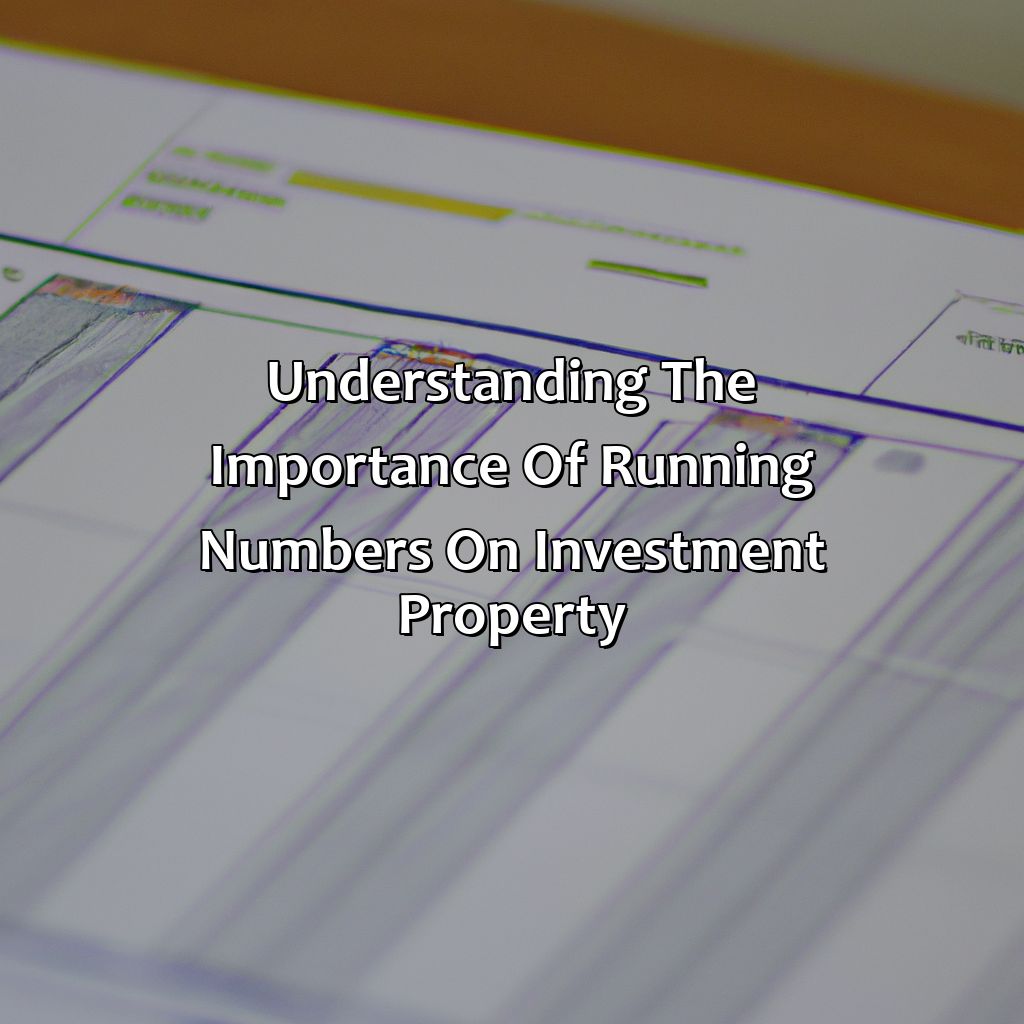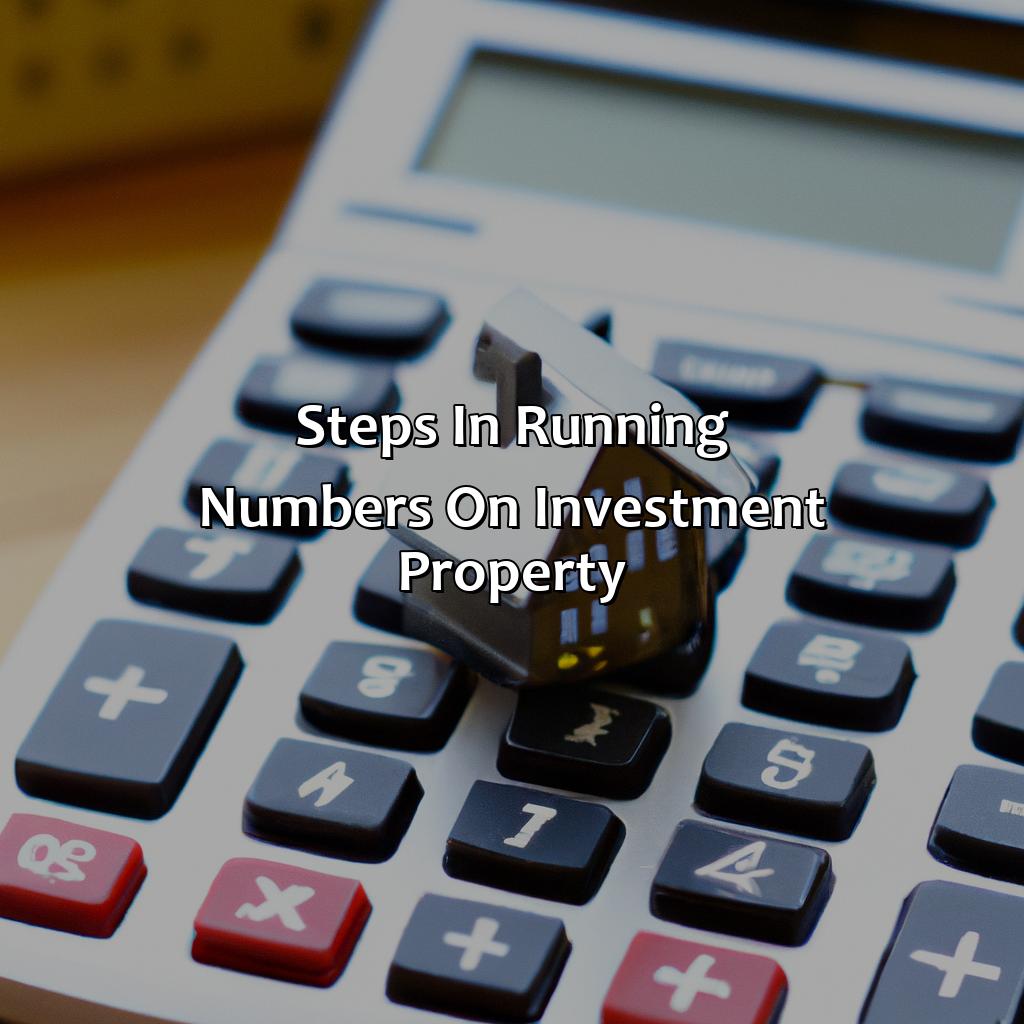How To Run Numbers On Investment Property?
Key Takeaway:
- Running numbers on investment property is crucial in determining its profitability and potential for success. Investors must consider both potential income and expected expenses to accurately forecast cash flow.
- Evaluating the property’s potential income involves researching rental rates in the area, vacancy rates, and the potential for rental increases over time. Expenses like property taxes, insurance, maintenance, and repairs must also be factored in.
- Once income and expenses have been projected, investors must analyze the property’s cash flow to determine its overall profitability. A positive cash flow is essential for a successful investment.
- Factors like location and market trends, property type and condition, and financing and tax implications must also be considered when running numbers on investment property. The more informed an investor is, the better they can project their return on investment and maximize profitability.
Are you considering investing in property? Get the facts and make an informed decision with our guide on running the numbers on investment property. With the right calculations, you can confidently make the right property investment decisions.
Understanding the Importance of Running Numbers on Investment Property
Investment Property Numbers: The Key to a Successful Investment
Running numbers on investment property is a crucial aspect of investing in the property market. Accurately estimating the costs and returns can make all the difference between a profitable investment and a poor one. It is imperative to understand how to calculate cash flow, net operating income (NOI), cap rate, and other financial metrics relevant to the property.
Knowing the worth of an investment property doesn’t just require collecting a few variables and running calculations. A deep analysis of the property’s market value, expenses, rental income potential, and risks is necessary. Each investment property has unique features that require an individual approach to determine its potential. Estimating costs accurately and forecasting returns can help assess the property’s real value.
To optimize returns, investors should explore tax benefits, financing options, and additional income streams. For instance, investors can explore income opportunities such as short-term rentals, long-term leases or capitalizing on strong capital appreciation, thereby maximizing their return on investment.
Pro Tip: It is crucial to approach any investment with caution and carry out thorough research before making a significant investment. Take your time analyzing the figures and estimating the returns. Remember, a well-informed investor is the key to a successful investment.

Image credits: retiregenz.com by James Washington
Steps in Running Numbers on Investment Property
Analyze investment property with ease. Evaluate potential income, ponder expenses and costs. Assess cash flow of property. This helps comprehend financial aspects and confirm profitability.

Image credits: retiregenz.com by Harry Washington
Evaluating the Property’s Potential Income
Evaluating Potential Income from Investment Property
To run numbers on investment property, it is crucial to evaluate the potential income that the property can generate. This involves determining all revenue streams and identifying costs that may be incurred.
- Identify rent potential by researching local rental rates for similar properties.
- Estimate occupancy rate by analyzing local demand and competition.
- Consider additional sources of income, such as laundry facilities or parking fees.
Additionally, it is important to factor in expenses, such as property taxes, maintenance costs, and mortgage payments.
To accurately evaluate potential income, it may be helpful to consult with a real estate agent or financial advisor who can provide valuable insights and guidance.
Ultimately, evaluating the potential income from investment property can help determine if the investment is viable and worth pursuing. By taking into account various factors and understanding the market conditions, investors can make informed decisions that will lead to greater returns on investment.
Running numbers on investment property is like being a detective, you have to consider every expense and cost to solve the mystery of profitability.
Considering Expenses and Costs
To evaluate the financial viability of an investment property, it is crucial to consider the various expenses and costs involved. This analysis will help you make informed decisions based on real numbers.
The following table shows some important expenses that must be considered while calculating the profitability of your investment property:
| Expenses | Description |
|---|---|
| Mortgage Payment | The monthly amount paid towards the mortgage |
| Insurance | Cost of insuring your investment property |
| Utilities | Water, electricity, gas bills |
| Property Taxes | Government taxes levied on your property |
| Repairs | Costs associated with repairing the property |
| HOA fees | Homeowners Association fees if applicable |
Be sure to include all other relevant costs and subtract them from your expected rental income to identify your net operating income (NOI) and overall ROI.
Beyond basic expenses like those listed in the table, don’t undermine other crucial factors such as vacancy rate or tenant turnover rate as these can impact your returns. Careful consideration of each expense item will lead to a better understanding of its impact on cash flow and overall profitability. One alternative approach could be investing in real estate management services for more oversight on these factors.
Overall, taking into account detailed expenses and costs when evaluating an investment property is key to making smart business investments. Analyzing cash flow is like flossing – it may seem tedious, but it’s necessary for a healthy investment property smile.
Analyzing the Property’s Cash Flow
To determine the financial health of an investment property, analyzing its cash flow is paramount. A detailed analysis would help in determining if an investor should proceed with the purchase or not.
The table below showcases an example of how to analyze a property’s cash flow. By calculating income and expenses, investors could arrive at an accurate Net Operating Income (NOI), Debt Service Coverage Ratio (DSCR), and Cash-on-Cash Return on Investment (COCROI) to determine profitability.
| Category | Figures |
|---|---|
| Gross Rental Income | $180,000 |
| Vacancy Rate | 3% |
| Effective Rental Income | $174,600 |
| Other Income | $10,000 |
| Total Income | $184,600 |
| Property Taxes | $15,000 |
| Insurance | $6,000 |
| Repairs & Maintenance | $12,000 |
| Utilities | $2,500 |
| Mortgage Payment | $85,619 |
| % Down Payment | $150000 |
| Mortgage Interest | $12,381 |
| % Closing Costs | $8000 |
By examining these details investors can evaluate whether their desired parameters are feasible for this specific property’s feasibility.
In addition to gross rental income and operating expenses reviewed above, investors also need to take into account ancillary factors such as historical market trends in home prices which may affect future appreciation and demand for rental properties in the area.
According to Forbes.com’s Real Estate section as of December 2020 “Real estate has consistently been a good investment over time.”
Running the numbers on an investment property is like taking a crash course in math, but with the added bonus of potential profits at the end.
Factors to Consider in Running Numbers on Investment Property
Analyzing investment property? Consider these factors!
- Location
- Market trends
- Type and condition of property
- Financing and taxes
Let’s look at each one individually for a better understanding.

Image credits: retiregenz.com by James Washington
Location and Market Trends
Investment properties require a comprehensive understanding of complex factors that may affect their profitability. One key consideration to evaluate the potential success of an investment property is to assess Location and Market Trends. By studying the market trends, investors can identify the current and expected demand for rental properties or houses in that area, which could impact the pricing and occupancy rates. Evaluating location factors such as proximity to essential amenities and transportation can be crucial for tenants, providing long-term stable cash flows for the investor.
Additionally, through advanced analytics methods like Machine Learning algorithms, analyzing vast data sets of historical prices, demographic information can aid in making informed decisions regarding mortgages or purchases in various locations.
In reviewing earlier market trends and researching previous fluctuations in real estate markets’ behavior across comparable neighborhoods another useful tool at an investor’s disposal to make more accurate forecasts, also regarding risk assessment while determining ROI. Alternatively, evaluating neighborhood crime rates alongside zoning regulations may have a potential detrimental impact on property value if located close by negative surroundings leading to low demand levels.
To ensure profitable investments investors should consider local economic indicators like job growth or population influxes. Knowing this data would assist them in shifting their investments towards more profitable regions as this guidance helps investors acquire an understanding of which areas may have sustained development over long periods of time while avoiding any changes that could alter primary plans ultimately assisting with positive cash flow.
Buying a fixer-upper is like getting a surprise birthday present, except it’s your wallet that’s surprised.
Property Type and Condition
The characteristics of the real estate property and its state are crucial for accurate investment calculations. Let’s explore more about the “Nature of Property and State.”
Without serious considerations about the property type and condition, investment decisions may end up with less desirable results. Here is a table summarizing crucial factors for each case.
| Property Type | Condition | Description |
|---|---|---|
| Single-family | New | Resale value brings higher profitability but requires higher capital investment |
| Condominium | Renovated | Present lower risks because a smaller achievable price makes repairing costs worthwhile |
| Multi-family | Fixer-upper | Potential for greater returns but calls for appropriate financing methods to carry out required building improvements |
It’s important to inquire further into relevant data like local market trends or zoning regulation updates according to each property type – for instance, whether there are incentives such as tax abatements or redevelopment breaks.
A wise suggestion would be having realistic long-term expectations on rental price escalation, project implementation time, limit possible contingencies by regularly executing routine inspection processes and product measurements as part of the leasing contract agreements’ clauses.
Financing and Tax Implications.
When analyzing investment property, one should take into account multiple factors that could affect financing and taxation implications. This includes understanding the property’s location, market trends, potential income, expenses, and financing options. Additionally, it is crucial to comprehend legal regulations and tax codes related to owning and renting out investment properties.
Moreover, selecting an adequate financing option can significantly impact the return on investment. An investor must analyze various loan terms, rates, and fees before choosing a mortgage lender. It is also beneficial to consider alternative sources of funding like private lenders or hard money loans.
Lastly, tax implications must not be overlooked when assessing the profitability of an investment property. Investors should evaluate potential deductions such as property taxes, depreciation expenses, and mortgage interest payments. It is also essential to comprehend how owning rental properties fits into one’s overall tax strategy.
According to Forbes’ analysis (source), rental properties have generated consistent returns over time compared to other types of investments like stocks or bonds.
Five Facts About How To Run Numbers On Investment Property:
To calculate net operating income (NOI), subtract operating expenses from gross rental income. (Source: BiggerPockets)
Cap rate is a ratio used to estimate the potential return on investment and is calculated by dividing NOI by the property’s value. (Source: MillionAcres)
Cash on cash return measures the annual return on investment based on the amount of cash invested and is calculated by dividing pre-tax cash flow by the cash invested. (Source: Investopedia)
A good rule of thumb is to aim for a cap rate of at least 5% and a cash on cash return of at least 8%. (Source: The Balance)
It’s essential to factor in additional expenses such as property management fees, maintenance costs, and vacancies, when running numbers on an investment property. (Source: REtipster)
FAQs about How To Run Numbers On Investment Property?
What does “running numbers” on an investment property mean?
Running numbers on an investment property means analyzing the financials of the property to determine whether it is a good investment. This includes calculating potential rental income, expenses, and returns on investment.
How do I calculate potential rental income for an investment property?
To calculate potential rental income, research the market rental rates for similar properties in the area. Multiply the average rental rate by the number of units in the property and the number of months in a year to get an estimated annual rental income.
What expenses should I consider when running numbers on an investment property?
Expenses to consider include property taxes, insurance, maintenance costs, vacancy rates, property management expenses, and any other fees associated with owning the property.
What are some key metrics to analyze when running numbers on an investment property?
Some key metrics to analyze include cash flow, cap rate, return on investment, and debt service coverage ratio. These metrics all help determine the profitability and risk of the investment.
What is a good cap rate for an investment property?
A good cap rate for an investment property varies by location and property type. Generally, a cap rate of 6% or higher is considered a good investment, although some areas may have higher or lower expectations.
What should I look for in a property when running numbers for an investment?
When running numbers on an investment property, look for a property in a desirable location with strong rental demand. The property should have good cash flow potential, minimal needed repairs or renovations, and a purchase price that allows for a good return on investment.
 Checkout this IRS Loophole
Checkout this IRS Loophole 
